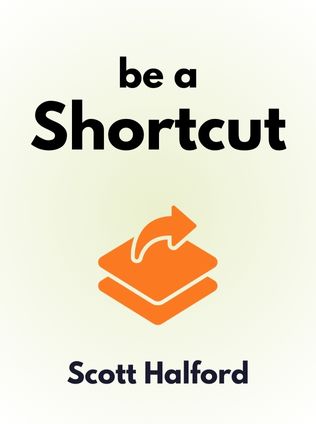
Be A Shortcut
The Secret Fast Track to Business Success
By Scott Halford
Published 12/2008
About the Author
Scott G. Halford is a distinguished speaker, consultant, and expert in emotional intelligence and professional mastery. He is the owner of Complete Intelligence LLC, a consultancy firm with prestigious clients such as Molson Coors, Medtronic, Microsoft, and Ingersoll Rand. Halford's extensive experience in helping individuals and organizations develop their professional skills and emotional intelligence has made him a sought-after expert in the field. His work is characterized by a deep understanding of human behavior and a commitment to helping professionals excel in their careers.
Main Idea
"Be a Shortcut: The Secret Fast Track to Business Success" by Scott G. Halford offers a comprehensive guide on how professionals can distinguish themselves and become indispensable in their workplaces. The book emphasizes the importance of emotional intelligence, mastery of specific skills, and a positive attitude in achieving professional success. Halford introduces the concept of 'shortcuts'—individuals who make processes easier and more efficient, thereby adding significant value to their organizations. By adopting the behaviors and mindsets of shortcuts, professionals can command respect, influence, and achieve their career goals.
Table of Contents
- Introduction: What a Shortcut Looks Like
- The Know-Why: The Shortcut Way
- The Know-What: How to Be a Shortcut
- The Know-How: The Quickest Personal Shortcut
- The Shortcut as a Company
- The Long and Shortcut of It
Introduction: What a Shortcut Looks Like
In the introduction, Halford sets the stage by illustrating what a shortcut embodies through an anecdote of a white-water rafting trip. During a perilous moment in the rapids, a rescuer acts as a lifeline, embodying the traits of a shortcut: being available when needed, performing tasks without complaint, and being an expert in their field.
"Shortcuts: Are there when you need them. Humbly do their jobs so that others can 'survive' and thrive in their jobs. Don't complain about having to sometimes carry the weight of others. Are happy to make you successful." - Scott G. Halford
This narrative sets the tone for the book, emphasizing that being a shortcut is about more than just efficiency; it's about reliability, expertise, and a positive attitude.
The Know-Why: The Shortcut Way
Halford defines a shortcut as "a shorter way to get to the same place" and "any way of saving time, effort, expense, and so on." He explains that shortcuts invest time to become experts, making them invaluable because they save others from having to figure things out on their own. This mutual benefit creates a magical relationship between the shortcut and those who rely on them.
Halford highlights the necessity of using shortcuts in today’s fast-paced world, where technological advancements have increased expectations and complexity in our lives. He advises that using shortcuts should not be seen as a cop-out but as a strategic way to achieve success without compromising quality.
"Using products and services as shortcuts is not a cop-out. Great shortcuts don't require you to give up quality, but they might require you to give up some money." - Scott G. Halford
He also introduces the concept of the "Shortcut Quotient Inventory (SQI)," a tool designed to help individuals assess their shortcut capabilities and identify areas for improvement. By honestly evaluating oneself, a professional can better understand their strengths and growth opportunities.
The Know-What: How to Be a Shortcut
Halford delves into practical steps for becoming a shortcut. He emphasizes the importance of efficiency processes like Six Sigma and Total Quality Management (TQM), which many companies use to find shortcuts. However, he notes that individuals shouldn't wait for their companies to adopt these programs to start being shortcuts. Instead, they should constantly look for ways to make their jobs easier, faster, and more efficient.
The author provides a valuable exercise to help professionals identify and leverage shortcuts in their lives:
- Make a list of personal and professional shortcuts you use.
- Identify areas where you can delegate tasks to others.
- Start small if budget constraints are an issue.
Halford uses the example of DoodyCalls, a pet waste removal company, to illustrate how becoming an expert in a niche market can lead to significant success. The more you excel in an area that others might overlook, the more valuable you become.
"The more you are willing to become an expert at something no one else wants to do - and do it with a great attitude - the more influential and valuable you become." - Scott G. Halford
He also introduces the concept of "flow," as studied by Mihaly Csikszentmihalyi, to describe the state of optimal performance where individuals feel a sense of timelessness and joy in their work. Mastery in one's field is key to achieving this state and becoming a highly sought-after shortcut.
Back-Road Basics
As with most shortcuts, it doesn't make sense to take the long road unless the shortcut is unethical, illegal, or leads to shoddy work. Winners in various fields use excellent shortcuts to achieve their goals. Halford explains that the rapid pace of technological advancements requires us to use shortcuts to maintain efficiency and well-being.
Sign up for FREE and get access to 1,400+ books summaries.
You May Also Like
The Subtle Art of Not Giving a F*ck
A Counterintuitive Approach to Living a Good Life
By Mark MansonRich Dad Poor Dad
What the Rich Teach Their Kids About Money - That the Poor and Middle Class Do Not!
By Robert T. KiyosakiHow To Win Friends and Influence People
The All-Time Classic Manual Of People Skills
By Dale CarnegieQuiet: The Power of Introverts
The Power of Introverts in a World That Can't Stop Talking
By Susan Cain



















